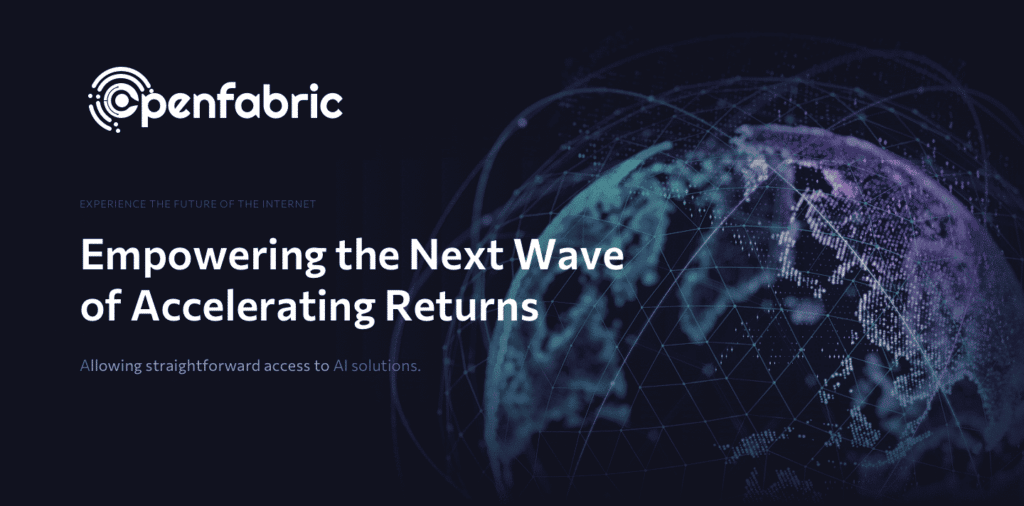
June 17, 2021 6 minutes read
Empowering the Next Wave of Accelerating Returns

What is the Law of Accelerating Returns?
Most people do not understand the concept of accelerating returns. Although not very popular outside the world of tech, we will be telling you shortly.
At Openfabric, we believe that we can create the next generation of technological advancements and unlock the exponential value contained therein. We hope to achieve this by strategically leveraging the powers of artificial intelligence (AI).
As we discuss the concept of accelerating returns, we are going to be uncovering how Openfabric hopes to achieve this.
The History of Discovery: the Beginning of Accelerating Returns.
What has been the most important invention or discovery of, say, the last 1,000 years? Was it the printing press, which came about in the 1430s? Was it when it was first available for commercial use in the late 19th century? What about penicillin, which was accidentally discovered in 1928 but has since saved countless lives? Semiconductors (mid-20th century, which gave birth to modern electronics)?
Countless other inventions and discoveries can be included on this list. For example nitrogen fixation, sanitation, refrigeration, engines (internal combustion and steam), and the Internet. Without any of the above, the world today would not be the same.
One can endlessly debate which invention or discovery was more important than the others. Hence exercises such as the above have led to the development of what we call the Law of Accelerating Returns. Get deeper insights about this here.
What is the law of accelerating returns?
The Law of Accelerating Returns states that technological advancements tend to occur at such a rapid pace that they outstrip the associated social and cultural change that they create.
For example, the Wright Brothers’ First Flight occurred in 1903, and humans landed on the moon a meager 66 years later.
Semiconductors were first patented as early as 1901. However, they have led to the development of countless new inventions over the past 120 years, including the personal computer, which helped in the creation of the Internet.
All these typically demonstrate the Law of Accelerating Returns.
In summary, some discoveries and inventions can open up amazing new opportunities for growth, development, and progress. Nevertheless, it is up to us to identify those opportunities and make the most of them.
Let us see, at a global level, the next depiction of the Law of Accelerating Returns.
The Law of Accelerating Returns As Seen Today
We believe the next revolutionary opportunity that will drive a new wave of radical global progress is the targeted and collaborative use of AI. To understand how and why, let’s take a step back and discuss the Law of Accelerating Returns in the context of the Internet.
At certain points in our collective history, very specific groundbreaking discoveries and inventions led to disproportionate advancements in multiple fields. The creation of the Internet, for example, was only possible after the discovery of electricity and the development of semiconductors.
It is followed by the ability for society to enjoy the health, education, collaboration, travel, and safety required to engage in meaningful scientific endeavors.
Each of those discoveries or inventions were important in their own right.
However, as important as every preceding invention or discovery was, it is the Internet that proved to be the revolutionary new technology. These include:
- GPS
- Web browsers
- Social media
- IoT devices
- AI technology
- The human genome project
- Molecular biology
- Quantum computing
- Blockchain technology and so much more.
The Next Wave of Accelerating Returns: Artificial Intelligence (AI)
We are now at a point in time where we are presented with the perfect storm to take things to the next level. Thanks to the Internet, the world is truly a global village. That means, it is easier than ever before to enter new markets, reach new audiences, deliver new products and services, and personalize services.
Furthermore, with big data, analytics, AI, and advanced computing capabilities just a cloud instance away, we can now do so much more faster than ever before. Now, we can make predictions, extract insights, analyze vast amounts of data, perform user testing, iterate designs, or do anything in between— seamlessly, and easily — with a few clicks or the touch of a few buttons.
After all, as Steve Jobs once famously said, “the computer is like a bicycle for the mind. It helps us get more done more quickly and at a lower cost.”
At Openfabric, we believe that next-gen AI tools are like a bicycle for computers. They endow computer programs with human-like capabilities and allow them to reason, learn, plan, and perform actions and execute commands. AI can also enable technical systems to navigate their environment, understand and react to data inputs, and solve complex problems to achieve specific goals. In other words, just as humans use the Internet for innovation, AI technology will allow us to do so via computers but on an entirely new level.
Unfortunately, the prevailing AI ecosystems of today are exceedingly fragmented and isolated. We lack the cohesive, inclusive, and collaborative environments required to stimulate mass adoption.
The Openfabric Solution
To address the issues with accelerating returns above, Openfabric has built a secure, decentralized, interoperable, and user-friendly platform that:
- Ensures no central entity controls the location of data or information processing.
- Protects end-user privacy and guarantees intellectual property rights.
- Uses standardized interfaces to allow multiple AI agents to collaborate, connect, and pool resources toward answering complex problems.
- Simplifies interactions between end-users and AI programs using non-technical workflows.
- Within the platform, a robust, built-in smart economy acts as an exchange for the supply and demand of AI services.
- The platform is entirely scalable as well; network participants can rent their computing power for the execution and training of AI programs.
Benefits and roles of a few key participants on the platform
Service consumers
They are end-users who need the power of AI to solve specific problems or improve their services with data-driven intelligence. They can enjoy seamless access to performant AI tools without the technical know-how typically required to use and train AI applications.
AI innovators
They are also known as the creators of AI programs. They are incentivized to use their expertise to create elaborate, practical AI algorithms that can solve complex real-world problems.
Infrastructure providers
These people provide the various hardware capabilities required to run and train AI applications.
Data providers
They provide the vast troves of data required to train and test AI algorithms. Companies that possess consistent datasets can profit by licensing this data on the platform for use by innovators and data providers.
Perks of using the Openfabric platform
The Openfabric platform connects the players above with the right tools, and builds the applications and infrastructures required to create a self-sustaining AI ecosystem. Through this they can deliver the following benefits:
Commoditized access to AI
Openfabric lowers AI adoption barriers by reducing the infrastructure and knowledge costs required for using AI algorithms. By doing so, they empower end-users with a new generation of intelligence-driven products and tools. These tools are accessible through Openfabric’s built-in peer-to-peer marketplace.
Securing intellectual property and fair competition between innovators.
This will lead to the creation of large, vibrant, and collaborative communities, expediting and catalyzing the evolution of intelligent algorithm solutions.
Scalability
Thanks to its decentralized design, Openfabric is inherently scalable and can absorb any infrastructure that adheres to the requirements of the ecosystem.
We can think of the benefits of human-driven, computer-empowered innovation of the last two decades as linear, and the benefits that AI-driven, computer-empowered innovation will create in the future as logarithmic. Although the future is unknown, we believe it to be exceptionally bright.
To learn more about the endless possibilities that Openfabric’s AI-driven innovation ecosystem can create, visit us openfabric.ai.

